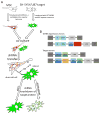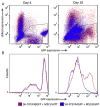Examination of mesenchymal stem cell-mediated RNAi transfer to Huntington's disease affected neuronal cells for reduction of huntingtin
- PMID: 22198539
- PMCID: PMC3784251
- DOI: 10.1016/j.mcn.2011.12.001
Examination of mesenchymal stem cell-mediated RNAi transfer to Huntington's disease affected neuronal cells for reduction of huntingtin
Abstract
Huntington's disease (HD) is a fatal, autosomal dominant neurodegenerative disorder caused by an expanded trinucleotide (CAG) repeat in exon 1 of the huntingtin gene (Htt). This expansion creates a toxic polyglutamine tract in the huntingtin protein (HTT). Currently, there is no treatment for either the progression or prevention of the disease. RNA interference (RNAi) technology has shown promise in transgenic mouse models of HD by reducing expression of mutant HTT and slowing disease progression. The advancement of RNAi therapies to human clinical trials is hampered by problems delivering RNAi to affected neurons in a robust and sustainable manner. Mesenchymal stem cells (MSC) have demonstrated a strong safety profile in both completed and numerous ongoing clinical trials. MSC exhibit a number of innate therapeutic effects, such as immune system modulation, homing to injury, and cytokine release into damaged microenvironments. The ability of MSC to transfer larger molecules and even organelles suggested their potential usefulness as delivery vehicles for therapeutic RNA inhibition. In a series of model systems we have found evidence that MSC can transfer RNAi targeting both reporter genes and mutant huntingtin in neural cell lines. MSC expressing shRNA antisense to GFP were found to decrease expression of GFP in SH-SY5Y cells after co-culture when assayed by flow cytometry. Additionally MSC expressing shRNA antisense to HTT were able to decrease levels of mutant HTT expressed in both U87 and SH-SY5Y target cells when assayed by Western blot and densitometry. These results are encouraging for expanding the therapeutic abilities of both RNAi and MSC for future treatments of Huntington's disease.
Copyright © 2011 Elsevier Inc. All rights reserved.
Figures







Similar articles
-
RNA interference improves motor and neuropathological abnormalities in a Huntington's disease mouse model.Proc Natl Acad Sci U S A. 2005 Apr 19;102(16):5820-5. doi: 10.1073/pnas.0501507102. Epub 2005 Apr 5. Proc Natl Acad Sci U S A. 2005. PMID: 15811941 Free PMC article.
-
AAV vector-mediated RNAi of mutant huntingtin expression is neuroprotective in a novel genetic rat model of Huntington's disease.Mol Ther. 2008 May;16(5):947-56. doi: 10.1038/mt.2008.50. Epub 2008 Mar 25. Mol Ther. 2008. PMID: 18388917 Free PMC article.
-
High-capacity adenoviral vector-mediated reduction of huntingtin aggregate load in vitro and in vivo.Hum Gene Ther. 2007 Apr;18(4):303-11. doi: 10.1089/hum.2006.160. Hum Gene Ther. 2007. PMID: 17472569
-
Delivering a disease-modifying treatment for Huntington's disease.Drug Discov Today. 2015 Jan;20(1):50-64. doi: 10.1016/j.drudis.2014.09.011. Epub 2014 Sep 26. Drug Discov Today. 2015. PMID: 25256777 Review.
-
RNAi-based therapies for Huntington's disease: delivery challenges and opportunities.Ther Deliv. 2012 Sep;3(9):1061-76. doi: 10.4155/tde.12.80. Ther Deliv. 2012. PMID: 23035592 Review.
Cited by
-
Exploring extracellular vesicles as mediators of clinical disease and vehicles for viral therapeutics: Insights from the COVID-19 pandemic.Extracell Vesicles Circ Nucl Acids. 2022;3(3):172-188. doi: 10.20517/evcna.2022.19. Epub 2022 Jul 19. Extracell Vesicles Circ Nucl Acids. 2022. PMID: 35929616 Free PMC article.
-
Modeling Huntington's disease with induced pluripotent stem cells.Mol Cell Neurosci. 2013 Sep;56:50-64. doi: 10.1016/j.mcn.2013.02.005. Epub 2013 Feb 28. Mol Cell Neurosci. 2013. PMID: 23459227 Free PMC article. Review.
-
Genetically engineered mesenchymal stem cells as a proposed therapeutic for Huntington's disease.Mol Neurobiol. 2012 Feb;45(1):87-98. doi: 10.1007/s12035-011-8219-8. Epub 2011 Dec 9. Mol Neurobiol. 2012. PMID: 22161544 Free PMC article. Review.
-
Allele-Specific Reduction of the Mutant Huntingtin Allele Using Transcription Activator-Like Effectors in Human Huntington's Disease Fibroblasts.Cell Transplant. 2016;25(4):677-86. doi: 10.3727/096368916X690863. Epub 2016 Feb 4. Cell Transplant. 2016. PMID: 26850319 Free PMC article.
-
Human Mesenchymal Stem Cells Genetically Engineered to Overexpress Brain-derived Neurotrophic Factor Improve Outcomes in Huntington's Disease Mouse Models.Mol Ther. 2016 May;24(5):965-77. doi: 10.1038/mt.2016.12. Epub 2016 Jan 14. Mol Ther. 2016. PMID: 26765769 Free PMC article.
References
-
- Biedler JL, Roffler-Tarlov S, Schachner M, Freedman LS. Multiple neurotransmitter synthesis by human neuroblastoma cell lines and clones. Cancer Res. 1978;38:3751–3757. - PubMed
Publication types
MeSH terms
Substances
Grants and funding
LinkOut - more resources
Full Text Sources
Other Literature Sources

